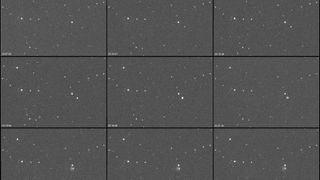Astronomers stunned as binary asteroid Didymos-Dimorphos brightens after DART space rock impact
"This is exceeding my expectations a lot!"

Astronomers watched in awe as binary asteroid Didymos brightened up immediately after the impact of NASA's DART spacecraft on Monday (Sept. 26).
Italian astronomer Gianluca Masi couldn't contain his excitement at the sight as he shared the observations in a livestream via the Virtual Telescope project. A small, dim dot that marked the Didymos-Dimorphos binary asteroid, at that time some 7 million miles (11 million kilometers) from Earth, began rapidly brightening and within minutes outshined even the brightest of stars in that tiny section of the sky.
"This is exceeding my expectations a lot," Masi said in the stream. "The object is now nearly 3 magnitudes brighter than earlier, this is tens of times more!"
Related: Asteroid impact: Here's the last thing NASA's DART spacecraft saw before it crashed

Since Italy was outside of the region with a direct view of Didymos at the time of the collision, Masi viewed the asteroid via a 12-inch (30 centimeters) telescope at South Africa's Klein Karoo Observatory in a feed shared by amateur astronomer Berto Monard.
The two astronomers watched in awe as Didymos not only brightened up, but also grew in size and changed shape as the cloud of debris stirred by DART's impact quickly spread in the surrounding space.
"Soon after the impact, an amount of dust was released like a plume and now this cloud of dust is expanding, sending back light from the sun," Monard explained in the stream. "This is much more than what I could expect. Even the shape is a bit different. It's like a comet. There are particles that are moving away from the asteroid and that's why you have a bigger halo of light."
Get the Space.com Newsletter
Breaking space news, the latest updates on rocket launches, skywatching events and more!
Masi added that the only other time astronomers could observe such a human-made brightening of a celestial object was in 2005 when NASA's Deep Impact probe intentionally collided with Comet Tempel 1. The goal of that mission, however, wasn't to change the comet's trajectory but to extract some material from its surface to enable scientists to learn more about the composition of these ice balls.
"At that time, I could record a brightness increase, but I have to say that this is by far much more dramatic," Masi commented on his observations of Deep Impact's encounter with the comet.
Telescopes all over the world are currently aiming at the Didymos binary asteroid hoping to learn all they can about the cloud of debris stirred by DART's impact and about the effects the collision had on the orbit of the 560-foot-wide (170 meters) moonlet Dimorphos around the 2,560-foot-wide (780 m) main asteroid Didymos. Altering Dimorphos' orbit around Didymos by at least 73 seconds was the primary purpose of the DART mission.
If last night's impact was successful, the DART experiment could lead to technology that humankind might need one day to protect itself from a space rock on a collision course with Earth.
Follow Tereza Pultarova on Twitter @TerezaPultarova. Follow us on Twitter @Spacedotcom and on Facebook.
Join our Space Forums to keep talking space on the latest missions, night sky and more! And if you have a news tip, correction or comment, let us know at: community@space.com.

Tereza is a London-based science and technology journalist, aspiring fiction writer and amateur gymnast. Originally from Prague, the Czech Republic, she spent the first seven years of her career working as a reporter, script-writer and presenter for various TV programmes of the Czech Public Service Television. She later took a career break to pursue further education and added a Master's in Science from the International Space University, France, to her Bachelor's in Journalism and Master's in Cultural Anthropology from Prague's Charles University. She worked as a reporter at the Engineering and Technology magazine, freelanced for a range of publications including Live Science, Space.com, Professional Engineering, Via Satellite and Space News and served as a maternity cover science editor at the European Space Agency.
